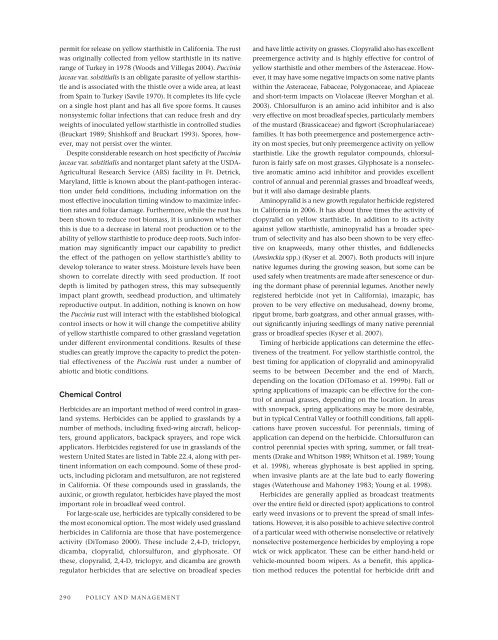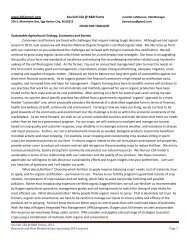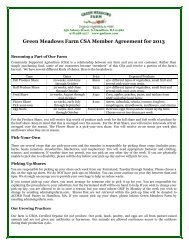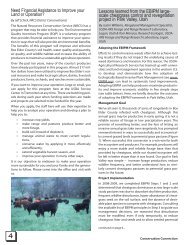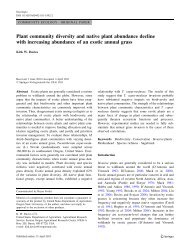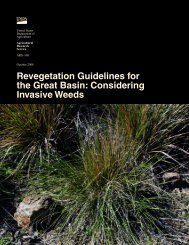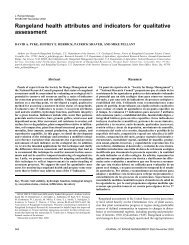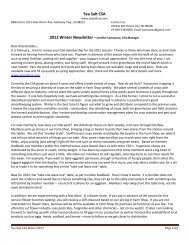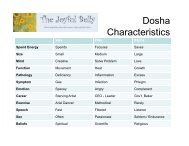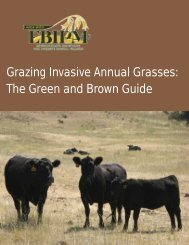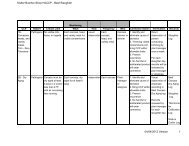Exotic Plant Management in California Annual Grasslands
Exotic Plant Management in California Annual Grasslands
Exotic Plant Management in California Annual Grasslands
Create successful ePaper yourself
Turn your PDF publications into a flip-book with our unique Google optimized e-Paper software.
permit for release on yellow starthistle <strong>in</strong> <strong>California</strong>. The rustwas orig<strong>in</strong>ally collected from yellow starthistle <strong>in</strong> its nativerange of Turkey <strong>in</strong> 1978 (Woods and Villegas 2004). Pucc<strong>in</strong>iajaceae var. solstitialis is an obligate parasite of yellow starthistleand is associated with the thistle over a wide area, at leastfrom Spa<strong>in</strong> to Turkey (Savile 1970). It completes its life cycleon a s<strong>in</strong>gle host plant and has all five spore forms. It causesnonsystemic foliar <strong>in</strong>fections that can reduce fresh and dryweights of <strong>in</strong>oculated yellow starthistle <strong>in</strong> controlled studies(Bruckart 1989; Shishkoff and Bruckart 1993). Spores, however,may not persist over the w<strong>in</strong>ter.Despite considerable research on host specificity of Pucc<strong>in</strong>iajaceae var. solstitialis and nontarget plant safety at the USDA-Agricultural Research Service (ARS) facility <strong>in</strong> Ft. Detrick,Maryland, little is known about the plant-pathogen <strong>in</strong>teractionunder field conditions, <strong>in</strong>clud<strong>in</strong>g <strong>in</strong>formation on themost effective <strong>in</strong>oculation tim<strong>in</strong>g w<strong>in</strong>dow to maximize <strong>in</strong>fectionrates and foliar damage. Furthermore, while the rust hasbeen shown to reduce root biomass, it is unknown whetherthis is due to a decrease <strong>in</strong> lateral root production or to theability of yellow starthistle to produce deep roots. Such <strong>in</strong>formationmay significantly impact our capability to predictthe effect of the pathogen on yellow starthistle’s ability todevelop tolerance to water stress. Moisture levels have beenshown to correlate directly with seed production. If rootdepth is limited by pathogen stress, this may subsequentlyimpact plant growth, seedhead production, and ultimatelyreproductive output. In addition, noth<strong>in</strong>g is known on howthe Pucc<strong>in</strong>ia rust will <strong>in</strong>teract with the established biologicalcontrol <strong>in</strong>sects or how it will change the competitive abilityof yellow starthistle compared to other grassland vegetationunder different environmental conditions. Results of thesestudies can greatly improve the capacity to predict the potentialeffectiveness of the Pucc<strong>in</strong>ia rust under a number ofabiotic and biotic conditions.Chemical ControlHerbicides are an important method of weed control <strong>in</strong> grasslandsystems. Herbicides can be applied to grasslands by anumber of methods, <strong>in</strong>clud<strong>in</strong>g fixed-w<strong>in</strong>g aircraft, helicopters,ground applicators, backpack sprayers, and rope wickapplicators. Herbicides registered for use <strong>in</strong> grasslands of thewestern United States are listed <strong>in</strong> Table 22.4, along with pert<strong>in</strong>ent<strong>in</strong>formation on each compound. Some of these products,<strong>in</strong>clud<strong>in</strong>g picloram and metsulfuron, are not registered<strong>in</strong> <strong>California</strong>. Of these compounds used <strong>in</strong> grasslands, theaux<strong>in</strong>ic, or growth regulator, herbicides have played the mostimportant role <strong>in</strong> broadleaf weed control.For large-scale use, herbicides are typically considered to bethe most economical option. The most widely used grasslandherbicides <strong>in</strong> <strong>California</strong> are those that have postemergenceactivity (DiTomaso 2000). These <strong>in</strong>clude 2,4-D, triclopyr,dicamba, clopyralid, chlorsulfuron, and glyphosate. Ofthese, clopyralid, 2,4-D, triclopyr, and dicamba are growthregulator herbicides that are selective on broadleaf speciesand have little activity on grasses. Clopyralid also has excellentpreemergence activity and is highly effective for control ofyellow starthistle and other members of the Asteraceae. However,it may have some negative impacts on some native plantswith<strong>in</strong> the Asteraceae, Fabaceae, Polygonaceae, and Apiaceaeand short-term impacts on Violaceae (Reever Morghan et al.2003). Chlorsulfuron is an am<strong>in</strong>o acid <strong>in</strong>hibitor and is alsovery effective on most broadleaf species, particularly membersof the mustard (Brassicaceae) and figwort (Scrophulariaceae)families. It has both preemergence and postemergence activityon most species, but only preemergence activity on yellowstarthistle. Like the growth regulator compounds, chlorsulfuronis fairly safe on most grasses. Glyphosate is a nonselectivearomatic am<strong>in</strong>o acid <strong>in</strong>hibitor and provides excellentcontrol of annual and perennial grasses and broadleaf weeds,but it will also damage desirable plants.Am<strong>in</strong>opyralid is a new growth regulator herbicide registered<strong>in</strong> <strong>California</strong> <strong>in</strong> 2006. It has about three times the activity ofclopyralid on yellow starthistle. In addition to its activityaga<strong>in</strong>st yellow starthistle, am<strong>in</strong>opyralid has a broader spectrumof selectivity and has also been shown to be very effectiveon knapweeds, many other thistles, and fiddlenecks(Ams<strong>in</strong>ckia spp.) (Kyser et al. 2007). Both products will <strong>in</strong>jurenative legumes dur<strong>in</strong>g the grow<strong>in</strong>g season, but some can beused safely when treatments are made after senescence or dur<strong>in</strong>gthe dormant phase of perennial legumes. Another newlyregistered herbicide (not yet <strong>in</strong> <strong>California</strong>), imazapic, hasproven to be very effective on medusahead, downy brome,ripgut brome, barb goatgrass, and other annual grasses, withoutsignificantly <strong>in</strong>jur<strong>in</strong>g seedl<strong>in</strong>gs of many native perennialgrass or broadleaf species (Kyser et al. 2007).Tim<strong>in</strong>g of herbicide applications can determ<strong>in</strong>e the effectivenessof the treatment. For yellow starthistle control, thebest tim<strong>in</strong>g for application of clopyralid and am<strong>in</strong>opyralidseems to be between December and the end of March,depend<strong>in</strong>g on the location (DiTomaso et al. 1999b). Fall orspr<strong>in</strong>g applications of imazapic can be effective for the controlof annual grasses, depend<strong>in</strong>g on the location. In areaswith snowpack, spr<strong>in</strong>g applications may be more desirable,but <strong>in</strong> typical Central Valley or foothill conditions, fall applicationshave proven successful. For perennials, tim<strong>in</strong>g ofapplication can depend on the herbicide. Chlorsulfuron cancontrol perennial species with spr<strong>in</strong>g, summer, or fall treatments(Drake and Whitson 1989; Whitson et al. 1989; Younget al. 1998), whereas glyphosate is best applied <strong>in</strong> spr<strong>in</strong>g,when <strong>in</strong>vasive plants are at the late bud to early flower<strong>in</strong>gstages (Waterhouse and Mahoney 1983; Young et al. 1998).Herbicides are generally applied as broadcast treatmentsover the entire field or directed (spot) applications to controlearly weed <strong>in</strong>vasions or to prevent the spread of small <strong>in</strong>festations.However, it is also possible to achieve selective controlof a particular weed with otherwise nonselective or relativelynonselective postemergence herbicides by employ<strong>in</strong>g a ropewick or wick applicator. These can be either hand-held orvehicle-mounted boom wipers. As a benefit, this applicationmethod reduces the potential for herbicide drift and290 POLICY AND MANAGEMENT


